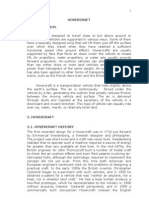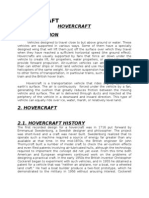Abst
Abst
Uploaded by
Srinivasa Reddy Devi ReddyCopyright:
Available Formats
Abst
Abst
Uploaded by
Srinivasa Reddy Devi ReddyOriginal Description:
Original Title
Copyright
Available Formats
Share this document
Did you find this document useful?
Is this content inappropriate?
Copyright:
Available Formats
Abst
Abst
Uploaded by
Srinivasa Reddy Devi ReddyCopyright:
Available Formats
ABSTRACT
Military Secure Airliner The main implementation of this project is to carries the military goods where the absence of human race. Here we use an Airliner to lift the various goods and transport to spy places. This conventional aircraft is able to fly because the forward motion of its angled wings forces air downwards, creating an opposite reaction called lift that forces the wings upwards. A helicopter uses exactly the same method, except that instead of moving the entire aircraft, only the wings themselves are moved. The helicopter's rotor can simply be regarded as rotating wings. Turning the rotor generates lift but it also applies a reverse force to the vehicle that would spin the helicopter in the opposite direction to the rotor. At low speeds, the most common way to counteract this torque is to have a smaller vertical propeller mounted at the rear of the aircraft called a tail rotor. This rotor creates thrust which is in the opposite direction from the torque generated by the main rotor. When the thrust from the tail rotor is sufficient to cancel out the torque from the main rotor, the helicopter will not rotate around the main rotor shaft. If the tail rotor is shrouded (i.e., a fan embedded in the vertical tail) it is called a fenestron. A fenestron rotor uses a belt driven system to turn the fan and is less efficient, but less noisy than a traditional tail rotor. Other helicopters use a "Notar" design: they blow air through a long slot along the tail boom, utilizing thecoanda effect to produce forces to counter the torque. Notar is an acronym meaning no tail rotor. Notars adjust thrust by opening and closing a sliding circular cover near the end of the tail boom. Another alternative, which saves the weight of a tail boom and rotor but adds its own complexities, is to use two large horizontal rotors which turn in opposite directions. All of these systems are designed for the same purpose: to produce a net rotational speed of zero. The amount of power required to prevent a helicopter from spinning is significant. A tail rotor can use up to 30% of the engine's power, and this power does not help the helicopter produce lift or forward motion. To reduce this waste during cruise, the tailfin is angled to produce a sideways lift which helps counter the main rotor torque. At high speeds, it is common for the tailfin to counteract the entire torque, thus leaving more power available for forward flight. This is commonly known as slip-streaming and can occur while in a hover on windy days making hovering turns difficult. Applications: Some more uses, both military and civil, including troop transportation, infantry support, firefighting, shipboard operations, business transportation, casualty evacuation (including air/sea/mountain rescue), police and civilian surveillance, carrying goods (some helicopters can carry slung loads, accommodating awkwardly shaped items), or as a mount for still, film or television cameras.
You might also like
- CE-560XL & XLS - Memory - Limitations CardDocument2 pagesCE-560XL & XLS - Memory - Limitations Cardgambit_zeta80% (5)
- Service Manual Extra 300LDocument431 pagesService Manual Extra 300LBenamor NejibNo ratings yet
- Boeing 767 300 Landing GearDocument15 pagesBoeing 767 300 Landing GearWorawat Wongratanamajcha100% (2)
- Helicopter Operation and Systems - Lec 8Document50 pagesHelicopter Operation and Systems - Lec 8aahsan345No ratings yet
- Notes On Delta WingDocument8 pagesNotes On Delta WingRAJ MOHANNo ratings yet
- Helicopter DesignDocument4 pagesHelicopter DesignThomas MouraNo ratings yet
- Homebuilt Aircraft Drag ReductionDocument15 pagesHomebuilt Aircraft Drag ReductionYvess100% (2)
- Helicopters and HovercraftsDocument14 pagesHelicopters and Hovercraftstushar joshiNo ratings yet
- Design of Apache HelicopterDocument19 pagesDesign of Apache HelicopterMed PadilNo ratings yet
- BibliographyDocument3 pagesBibliographytymakzNo ratings yet
- Unit 1Document5 pagesUnit 1Martin NadarNo ratings yet
- The Compound Helicopter Configuration and TheDocument7 pagesThe Compound Helicopter Configuration and Theghoopp76No ratings yet
- Write Up For Main Rotor System Edited FinalDocument13 pagesWrite Up For Main Rotor System Edited FinalSean Andrew Conti MagadiaNo ratings yet
- Design and Development of SwashplateDocument58 pagesDesign and Development of SwashplateNsv DineshNo ratings yet
- PPTDocument44 pagesPPTkarthick ram selvamNo ratings yet
- Swash PlateDocument14 pagesSwash PlateSwmdwn Basumatary100% (1)
- Which Control The Pitch Angle of The Tail Rotor Blades: by Pressing On The Right Pedal, The Pitch IsDocument5 pagesWhich Control The Pitch Angle of The Tail Rotor Blades: by Pressing On The Right Pedal, The Pitch IsAina AfifahNo ratings yet
- How Can Helicopter Fly: GeneralDocument31 pagesHow Can Helicopter Fly: GeneralBrandon Red BaronNo ratings yet
- Helicopter's Flying MechanismDocument23 pagesHelicopter's Flying MechanismRoxcyyyy100% (1)
- NOTORDocument19 pagesNOTORHEMANT THAKURNo ratings yet
- OrnithopterDocument8 pagesOrnithopterSabik Nainar0% (1)
- HovercraftDocument6 pagesHovercraftSibasish SahuNo ratings yet
- Rotor Blade Head DesignDocument8 pagesRotor Blade Head DesignAmitanand Surlikerimath100% (1)
- HovercraftsDocument8 pagesHovercraftsJithin VgNo ratings yet
- How Hovercrafts WorkDocument10 pagesHow Hovercrafts WorkHarish VermaNo ratings yet
- Auto RotationDocument4 pagesAuto RotationCarlos Castillo Palma100% (1)
- Fixed Wing Vs Rotary Wing AircraftDocument6 pagesFixed Wing Vs Rotary Wing AircraftMuhammad AmmadNo ratings yet
- HovercraftDocument7 pagesHovercraftBhalachandra KhareNo ratings yet
- Helicopter 1Document28 pagesHelicopter 1chelsyNo ratings yet
- M13.1.c-Rotary WingDocument13 pagesM13.1.c-Rotary Wingirene pafraNo ratings yet
- Aircraft Brake SystemDocument3 pagesAircraft Brake SystemYadana1No ratings yet
- Hovercrafts PDocument8 pagesHovercrafts Pmagini zijuNo ratings yet
- OrnithopterDocument9 pagesOrnithopterHari Haran JayaramanNo ratings yet
- How Helicopters Fly: Cesar Vandevelde 3io Technological Design EngineeringDocument28 pagesHow Helicopters Fly: Cesar Vandevelde 3io Technological Design EngineeringPor PenglengNo ratings yet
- Helicopter RotorDocument14 pagesHelicopter RotorRoshith Nair100% (1)
- Bond GraphDocument5 pagesBond GraphMila Dhari NovianaNo ratings yet
- Helicopter RotorDocument18 pagesHelicopter RotorAswin Harippad100% (2)
- 14008A ch7 PDFDocument27 pages14008A ch7 PDFtmt IngNo ratings yet
- Design and Fabrication of Hovercraft PDFDocument4 pagesDesign and Fabrication of Hovercraft PDFAniket UgleNo ratings yet
- Investigatory ProjectbnnbDocument13 pagesInvestigatory ProjectbnnbLucky Anthony GastonNo ratings yet
- HovercraftsDocument7 pagesHovercraftsJyoti SinghNo ratings yet
- Helicopter Aerodynamics, Structures and SystemsDocument414 pagesHelicopter Aerodynamics, Structures and SystemsJason Jia100% (11)
- FligtDocument11 pagesFligt20AE040 RajkumarNo ratings yet
- Simulation of Longitudinal Stability of Helicopter in Forward FlightDocument20 pagesSimulation of Longitudinal Stability of Helicopter in Forward FlightanmarhamidaliNo ratings yet
- Aircraft PartsDocument4 pagesAircraft PartsagaNo ratings yet
- Classes of RotorcraftDocument13 pagesClasses of RotorcraftJohan M Syafi'iNo ratings yet
- Simulation of Longitudinal Stability of Helicopter in Forward FlightDocument20 pagesSimulation of Longitudinal Stability of Helicopter in Forward FlightRahulNo ratings yet
- PropellersDocument13 pagesPropellerstatomhNo ratings yet
- Pia Report CompleteDocument24 pagesPia Report Completemamoor2No ratings yet
- Ropeller Erodynamics: Propeller AerodynamicsDocument5 pagesRopeller Erodynamics: Propeller AerodynamicstarabhmallyNo ratings yet
- ASE430 AssingmentDocument7 pagesASE430 AssingmentRajat KrishnaNo ratings yet
- ASE430 AssingmentDocument7 pagesASE430 AssingmentRajat KrishnaNo ratings yet
- ASE430 AssingmentDocument7 pagesASE430 AssingmentRajat KrishnaNo ratings yet
- ASE430 AssingmentDocument7 pagesASE430 AssingmentRajat KrishnaNo ratings yet
- Wind EnergyDocument22 pagesWind EnergyASHWANINo ratings yet
- Helicopter RotorDocument12 pagesHelicopter RotorklaaslaynNo ratings yet
- Principle of Helicopter FlightDocument7 pagesPrinciple of Helicopter Flightpriya dharshiniNo ratings yet
- How Helicopter Works How Helicopter Workshow Helicopter Workshow Helicopter Workshow Helicopter Workshow Helicopter WorksDocument11 pagesHow Helicopter Works How Helicopter Workshow Helicopter Workshow Helicopter Workshow Helicopter Workshow Helicopter Worksmrana_56No ratings yet
- Parts of An Airplane FuselageDocument4 pagesParts of An Airplane Fuselagevorontsovsky11No ratings yet
- Swashplate (Aeronautics) : 2 Cyclic Blade ControlDocument3 pagesSwashplate (Aeronautics) : 2 Cyclic Blade ControlRaghav Sachdeva100% (1)
- AMT214 A (Helicopter Design)Document2 pagesAMT214 A (Helicopter Design)ricky fluor50No ratings yet
- Basic Components of Aircraft: Elements of Aeronautics (13AE32) Unit-1 Part-2 Introduction To AircraftDocument16 pagesBasic Components of Aircraft: Elements of Aeronautics (13AE32) Unit-1 Part-2 Introduction To AircraftNavaneet V SreesomsonNo ratings yet
- Ornithopter Development and OperationDocument5 pagesOrnithopter Development and OperationSri KonguNo ratings yet
- TH TH TH THDocument8 pagesTH TH TH THSrinivasa Reddy Devi ReddyNo ratings yet
- Addressing ModesDocument6 pagesAddressing ModesSrinivasa Reddy Devi ReddyNo ratings yet
- Diode Clipping Circuits GoodDocument4 pagesDiode Clipping Circuits GoodSrinivasa Reddy Devi Reddy100% (1)
- Circuit Theory: Devices &circuitsDocument1 pageCircuit Theory: Devices &circuitsSrinivasa Reddy Devi ReddyNo ratings yet
- Solar Track1 51Document7 pagesSolar Track1 51Srinivasa Reddy Devi ReddyNo ratings yet
- Time e CH T Q I: ChargeDocument1 pageTime e CH T Q I: ChargeSrinivasa Reddy Devi ReddyNo ratings yet
- JSC-11542 - Flight Procedures Handbook Rev E 200504Document254 pagesJSC-11542 - Flight Procedures Handbook Rev E 200504davidjudahNo ratings yet
- Opportunities For A Liquid Rocket Feed System Based On Electric PumpsDocument7 pagesOpportunities For A Liquid Rocket Feed System Based On Electric PumpsdiegolenNo ratings yet
- Chapter4performanceparav2 28student 29Document19 pagesChapter4performanceparav2 28student 29Thiuyah A/p RajandranNo ratings yet
- (ID) How To Handle EmergencyDocument5 pages(ID) How To Handle EmergencyIrfan SafNo ratings yet
- Wind Turbine Airfoil CatalogueDocument152 pagesWind Turbine Airfoil CataloguepanosscribdNo ratings yet
- DME - DISTANCE MEASURING EQUIPMENT Opera PDFDocument18 pagesDME - DISTANCE MEASURING EQUIPMENT Opera PDFMohammadNo ratings yet
- NozzleDocument12 pagesNozzlePrinnia Zulfiqur BorshaNo ratings yet
- GPS ApplicationsDocument26 pagesGPS ApplicationskrrishNo ratings yet
- Vintage Airplane - Nov 1983Document20 pagesVintage Airplane - Nov 1983Aviation/Space History LibraryNo ratings yet
- Flow Across A NACA0012 AirfoilDocument28 pagesFlow Across A NACA0012 AirfoilThota Sri K Haritha100% (1)
- ADS-B Integrity - IFR6000 InstrDocument42 pagesADS-B Integrity - IFR6000 InstrMadhan GanesanNo ratings yet
- Driftdown and Oxygen Procedures Over High TerrainDocument22 pagesDriftdown and Oxygen Procedures Over High Terrainiceman737No ratings yet
- R/C Soaring Digest - Sep 2012Document90 pagesR/C Soaring Digest - Sep 2012Aviation/Space History LibraryNo ratings yet
- AHM560 737 500 Rev9 Trim UTairDocument50 pagesAHM560 737 500 Rev9 Trim UTairEnrique Alva Quintero100% (1)
- Aeroscience and Flight Mechanics DivisionDocument13 pagesAeroscience and Flight Mechanics DivisionBhukya VenkateshNo ratings yet
- Class II Methodology For Drag EstimationDocument80 pagesClass II Methodology For Drag EstimationBrian XistosNo ratings yet
- Navy Training System PlanDocument51 pagesNavy Training System Planedgareler100% (1)
- Regulations Structure PDFDocument1 pageRegulations Structure PDFSASNo ratings yet
- RocketDocument54 pagesRocketsuj12345No ratings yet
- Ltaw UcuyorumDocument5 pagesLtaw UcuyorumYigit Omer CiftciNo ratings yet
- MMELDocument3 pagesMMELRudro KumarNo ratings yet
- Harris David - Flight Instruments 2Document233 pagesHarris David - Flight Instruments 2Jose SaracinoNo ratings yet
- B.Tech - Aerospace Engineering PDFDocument138 pagesB.Tech - Aerospace Engineering PDFAnonymous RJfsy8PtNo ratings yet
- Easa Ad F-1994-085R2 1Document2 pagesEasa Ad F-1994-085R2 1lakshmimurugesanNo ratings yet
- ADP Flight SpecsDocument16 pagesADP Flight Specssanjay kumarNo ratings yet
- A330 b2 Ata46 Infomation Systems Basic - UnlockedDocument78 pagesA330 b2 Ata46 Infomation Systems Basic - UnlockedAaron Harvey0% (2)































































































